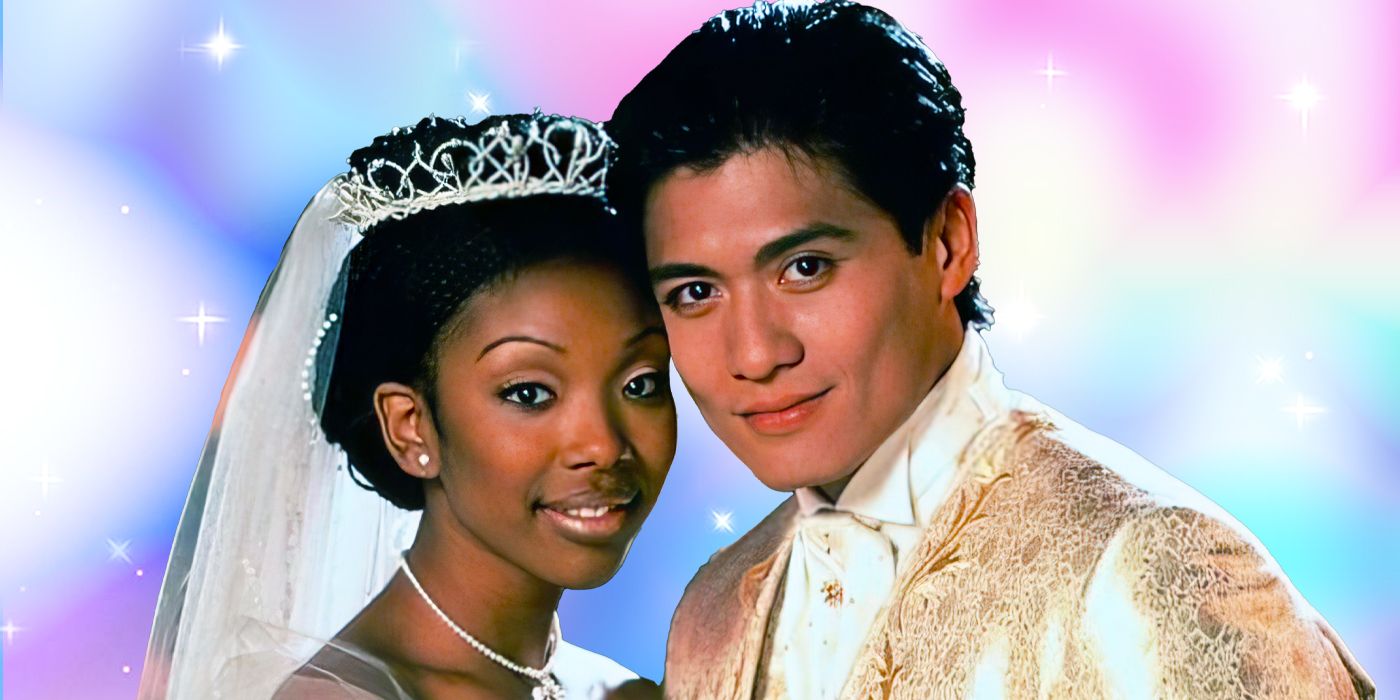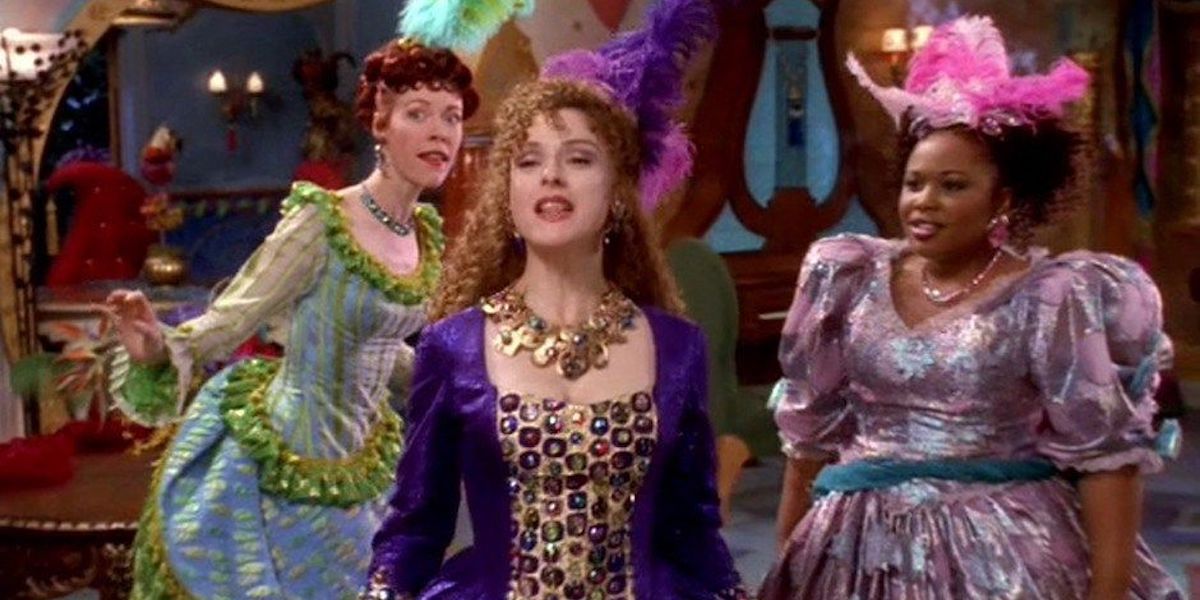Long ago, through the sands of time, I discovered 1997's classic Cinderella, starring Brandy Norwood as the titular lead and Whitney Houston as her Fairy Godmother. It happened not in a faraway land, but in an unassuming daycare. It was here, as a child, I found this treasure. On a plastic shelf, a bulky TV sat alongside a collection of VHS movies. Rodgers and Hammerstein’s Cinderella, as it's known in full, was among the choices to pick from – a tape snug in a clamshell case. How it wasn’t ruined by so many rewatches could be anyone’s guess. But rewatches were had, the “play” button hit primarily by me. If it isn’t obvious enough, I fell in love with this adaptation. Now 25 years old, this fairy tale adaptation remains as splendid as when it was first released. I, as queer adult, can understand how impactful this retelling of glass slippers and happy endings was because through the movie’s signature aspect of multicultural representation, amongst other elements, this rendition offers a very queer read of the classic fairy tale.
This Cinderella rendition was not just a TV movie, but a spectacle. Given a huge budget of $12 million, it was produced as part of the anthology series The Wonderful World of Disney. Disney even debuted the movie with a red carpet premiere where Brandy and her Prince Christopher Paolo Montalbán arrived via carriage ride. The movie was then released in on November 2, 1997 for TV audiences, where it became a ratings success. I knew none of this when I was a kid, my connection wasn’t part of the media hype. I watched this movie in the corner of a daycare, soaking in the sights and sounds. No matter the mundane viewing experience, it enamored me. Something that stuck with me was how much Cinderella was a showcase for divas. Whoopi Goldberg dialed up her acting as Queen Constantina, making intangible noises when flustered. Her son, Prince Christopher did not want another ball in order to find a bride. Bless Constantina's heart, she squeaked in disbelief.
'Cinderella' Offers New Takes on Queens, Stepmothers, & Godmothers
Having Victor Garber as King Maximillian, made for a great sense of irony. Garber, who publicly came out in 2013, is essentially the royal “straight man.” He looks on consolingly at his wife and son, leaving them to deal with their own drama. For the stepsiblings, Calliope (Veanne Cox) and Minerva (Natalie Desselle) also speak some genuine truth to an issue at hand. Why the hell does the Prince (or men in general) always prefer a certain type of woman? Sure, the two could go on about it in a better way. At the ball, the Prince doesn’t understand what Minerva is speaking about, to which she yells into his ear, “It’s poetry!” There’s something admirable about how forceful and demanding they were, especially with how timid Cinderella is. During the “Stepsisters’ Lament,” the Stepsisters get a spotlight where they voice absolute annoyance at seeing a pretty and petite princess dancing with the man of their dreams. Paired up, Cox and Desselle are the perfect comic relief. Like when they wedge themselves in a doorway because neither want to let go of a hat or when they cause themselves to tumble into a water fountain. Forceful and demanding, the Stepsisters are bratty and immature to Cinderella. And who could they have learned this behavior from?
Broadway legend Bernadette Peters dazzles as Cinderella's Stepmother in costuming, singing, and movements. For how cruel her take on Cinderella's Stepmother is, Peters plays the role with cruel glee. In Kendra James’ oral history of the production, she reveals that screenwriter Robert L. Freedman understood having Peters onboard meant a major revision - Bernadette Peters couldn't act in a musical and not sing! “When we ended up having Bernadette come on as the stepmother, we realized pretty quickly that we’d have to find her a song. That character doesn’t have one originally. I was told we could use any Rodgers and Hammerstein song that wasn’t closely tied with one of their most famous shows.” The song they picked was “Falling in Love with Love.” Leading up to the musical number, the Stepmother is draped in an aqua green robe, with pink frilly collars wrapping around like a snake. It’s beautifully ridiculous for a very bitter woman.
True love didn’t work out for the Stepmother, and she makes it clear to her family that a future in finding romance is laughable. The way Peters glides, twirls, and even tosses aside a pillow during “Falling in Love with Love”...it was all an enchanting sight for my young eyes. I couldn’t let it go. I took it all in and performed it, even getting reprimanded by a relative. Boys aren’t supposed to move like that – nevermind how majestic and elegant they are, I suppose. It stopped me from showing off in front of my family, but it did not stop me from polishing up the choreography from memory in the privacy of my own bedroom.
A shining jewel on top of this TV movie crown, would be Whitney Houston as the Fairy Godmother. Originally, Houston was to play Cinderella. Eventually Houston decided to play the Fairy Godmother role instead, and handpicked Brandy to play the titual fair maiden. Houston approached the Fairy Godmother role with magnificent presence, so much so that it's easy to forget how little screen time she actually has in the movie. Golden costuming makes her sparkle even without the added CGI effects. A cape attached to her wrists creates wings that move alongside her with grace. When I tried to use a bedsheet for a similar effect, my cheap attempt at drag couldn’t compare to Houston’s look. And her “Impossible/It’s possible” is a showstopper.
Brandy's take on Cinderella is nuanced compared to the Fairy Godmother and her stepfamily. Brandy as Cinderella fills the role with perseverance, her voice raspy and soft. Through Brandy's performance we see that Cinderella deserves the life she wants. Essentially, she needs the support of an ally to step out of the confines of her family. “Fabulous? Me?” Cinderella asked incredulously. Her Fairy Godmother never misses a beat: “Do you see anybody else in this room?” For many queer individuals, the toughest barriers to living an authentic life can often come, as they do for Cinderella, from relationships with relatives.
Cinderella's Stepmother Embodies Self-Criticism
Taking a closer look, the Stepmother is all about hiding imperfections or what she views as imperfections. Any quirks of any kind are a sty to her eye. She barks these ideas to her children, to hide their flaws, “until after their wedding.” Cinderella hears this and innocently questions her Stepmother's logic. “Shouldn't a man love you for who you are, in spite of everything?" Cinderella's Stepmothers constant put downs eventually get into her head. It takes her Fairy Godmother telling Cinderella: “You didn't need my help. You just thought you did. Believe in yourself, Cinderella, and trust him to love you as you really are.” for Cinderella to finally break out of that self-critical paradigm. In the previously referenced ET interview, Houston described what she hoped young viewers would take away from the movie. “Anything is possible, if you believe in yourself, that dreaming is just a dream if you don’t put it into effect,” she said. “If you don’t make it happen, if you don’t work your show, if you don’t handle your business, if you don’t move, you know, it doesn’t become anything.”
Being ridiculed for showing off dancing that is “too girly" is tame in comparison to more damaging mental and physical abuses queer individuals can have to deal with when it comes to familial pressures. Bigotry can come from anywhere, but coming from relatives it can feel especially painful. In the context of Cinderella, the lessons are all there. Surround yourself with people who believe in you and want you to be your true self. Yes, this is a fairy tale, where mice and pumpkins get turned into a fanciful means of hitching a ride, but they do so for Cinderella to attend a forbidden ball. Cinderella's stepfamily views her as unworthy of a better life, causing the young woman to retreat into her own little corner where, “I can be whatever I want to be.” But a safe space this limited isn't enough. To feel authentic, to truly feel alive, Cinderella has to step out. It doesn’t matter that she isn’t royal when Prince Christopher discovers the glass slipper can fit on her foot. The connection they made at the ball wasn’t based purely on her alluring blue gown.
Story & Character Weren't the Only Ways 'Cinderella' Promoted Inclusion
Beyond the film's main cast, the extras involved were just as key to the film's diverse vision. Executive producer Craig Zadan saw no need to comment on the casting diversity within the movie's script. Color saturating the final look of the film also played into the bigger intentions of inclusion. Zadan explained in Kendra James' oral history, “We wanted everything to be hyper colorful and richly vivid. That was the goal,” he continued. “We wanted the image on screen to have so much color in it – primary colors especially – that the skin colors almost dissipated in that you weren’t staring at ‘that person’s this or that’ because the design dictated that everyone became part of the same story.”
This decision sealed the deal. With so much inclusivity, and without commenting on it, the otherness within the film was normalized. Cinderella might not have LGBTQ+ characters or moments explicitly, but it is definitely a story about diversity and belonging. All those years ago, it was a movie sitting on a daycare shelf, waiting for a child to watch it again and again. With Cinderella's grand level of inclusivity, theatrical over-the-top acting, and a line-up of divas, this movie couldn’t help but become a queer classic. 25 years ago, this fairy tale showed a kind of world that shouldn’t only be limited to make believe. "It's possible!" makes for a timeless message to a diverse audience, including the LGBTQ+ community.


